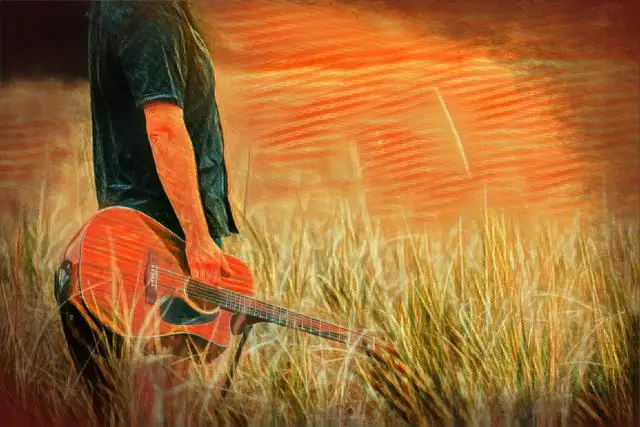Country music has a rich history with origins tracing back to blues, folk, and gospel music. This genre has also led to new ones, with subsets like Americana and honky tonk originating from this sonic space. But how does one make country music of their own?
To build distinctly country music, you need to use country chord progressions. Below, we'll detail exactly what country music is and show you how to use country chord progressions in your own music. Let's dive in!
What Is Country Music?
Country music has deep roots in the rural, southern regions of the United States. This genre is an amalgamation of other older genres that dominate the region such as blues, bluegrass, spirituals, gospel music, and American folk music.
Some of the oldest country music stars include artists like Jimmie Rodgers and Hank Williams:
Like any other genre, country music continues to evolve to this day, but there are a couple of common characteristics you'll typically hear throughout most country music:
Instrumentation
Country music uses plenty of instruments seen throughout folk music and other related genres. You'll certainly hear country guitar in hundreds of iterations, whether that's acoustic guitar, steel guitar, bass guitar, or lap steel guitar. You'll also find stringed instruments like the banjo, mandolin, or fiddle.
Other instruments like the piano or harmonica are also heard in popular country ballads. Pop country music will take in outside pop elements like programmed drums or even synthesizers to give the music a more danceable edge.
Subject Matter
Due to its origins, its no surprise that country music subjects are often based around life in the American south. You'll often hear depictions of blue collar work, life on the farm, faith and themes of love and loneliness. Country music revolves around capturing the experiences of everyday people.
Tone
Country music is often one of two extremes - tragically sad or heartbreaking, or absolutely carefree. While you can find a country song about anything and everything, this genre prioritizes imagery and storytelling above all else. There's a reason why country music has its own hub in Nashville outside of the national music hub of Los Angeles. Country music aims to be raw, honest, and relatable to the listener, showcasing the nuances of modern American life.
Modern iterations of country sometimes cross into pop music, with artists like Kacey Musgraves, Taylor Swift, and Shania Twain effortlessly blending genres:
5 Common Country Chord Progressions Every Artist Should Know
Without further ado, here are some of the most common country guitar chord progression patterns that every musician should know.
I IV V
The 1 4 5 is sometimes regarded as the country chord progression for its obvious popularity. This chord progression is extremely popular and heard in songs like Going Up The Country by canned heat with the C F G progression:
I V IV
This chord progression is very similar to the one above, with the dominant and subdominant flipped. You can hear it in country classics like Achy Brakey Heart :
I V IV Vi
This progression is super common throughout country music and pop music alike. Here are 7 songs any country guitar player can enjoy with these four chords alone:
12 Bar Blues
Since country music originated from older genres like blues, it's no surprise that there's some overlap when it comes to picking out a chord progression. This progression uses the aforementioned I IV and V chords in a specific pattern: The I chord is played for four measures, the IV chord for two measures, the I chord for two measures, the V chord for one measure, the IV chord for one measure, the I chord for one measure, finally finishing on the V chord. You can hear this progression at work in songs like Johnny Cash's God's Gonna Cut You Down :
Country Chord Progressions FAQ
Are you struggling to land some country chord progressions? Here are some commonly asked questions and answers to help you expand your understanding.
What are the most common chord progressions in country music?
The most common chord progressions in country music revolve around the major I, IV, and V chords. This is somewhat common across pop music, but country music weaves this popular chord progression with raw, vivid songwriting about everyday people.
What are the 3 chords of country music?
I IV V are regarded as the backbone of a country song. This isn't a hard and fast rule, but you'll find that a wide variety of country songs can be played utilizing this progression or variations of it.
What chords do country songs use?
Country songs usually use chords that have a strong relation to the tonic like I V vi IV or variations of these major chords. That being said, country music is a wide, varying genre, so this is largely a generalization.
What key are most country songs written in?
Most country songs are written in major keys like C G F Major using I IV V progressions or variations of it. Playing country progressions isn't overly complex in terms of music theory - the secret sauce is in the songwriting.
Country chord progressions are fairly simple but sound great as the backbone of country music. Hopefully, this guide makes it easier for you to decode popular country music so that you can enjoy playing your favorite songs. Have fun exploring this classic genre!





